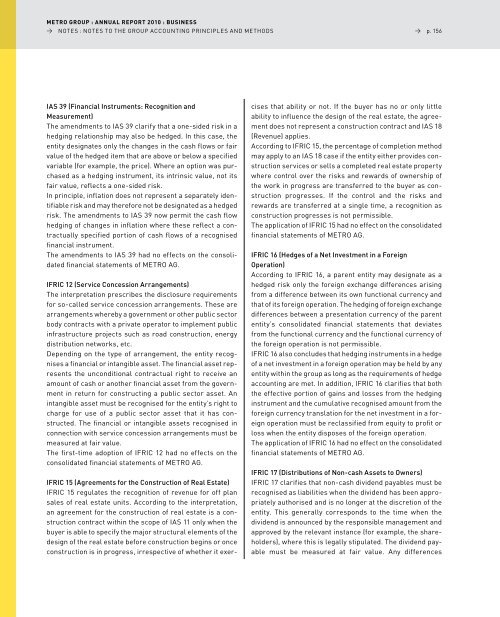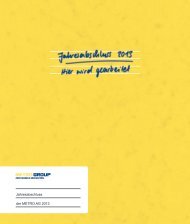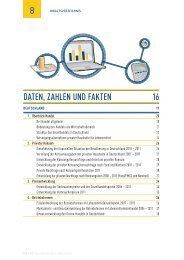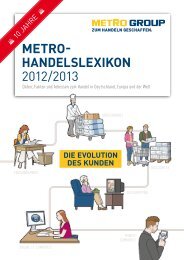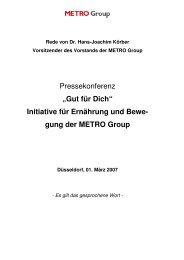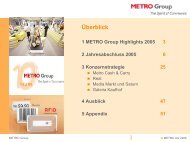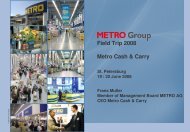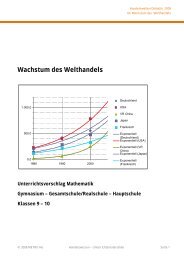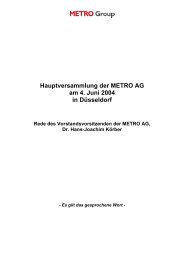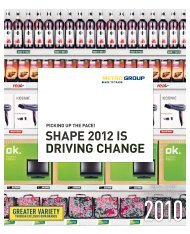pdf (2.5 MB) - METRO Group
pdf (2.5 MB) - METRO Group
pdf (2.5 MB) - METRO Group
You also want an ePaper? Increase the reach of your titles
YUMPU automatically turns print PDFs into web optimized ePapers that Google loves.
<strong>METRO</strong> GROUP : ANNUAL REPORT 2010 : BUSINESS<br />
→ NOTES : NOTES TO ThE GROuP ACCOuNTING PRINCIPlES ANd METhOdS<br />
IAS 39 (Financial Instruments: Recognition and<br />
Measurement)<br />
The amendments to IAS 39 clarify that a one-sided risk in a<br />
hedging relationship may also be hedged. In this case, the<br />
entity designates only the changes in the cash flows or fair<br />
value of the hedged item that are above or below a specified<br />
variable (for example, the price). Where an option was purchased<br />
as a hedging instrument, its intrinsic value, not its<br />
fair value, reflects a one-sided risk.<br />
In principle, inflation does not represent a separately identifiable<br />
risk and may therefore not be designated as a hedged<br />
risk. The amendments to IAS 39 now permit the cash flow<br />
hedging of changes in inflation where these reflect a contractually<br />
specified portion of cash flows of a recognised<br />
financial instrument.<br />
The amendments to IAS 39 had no effects on the consolidated<br />
financial statements of <strong>METRO</strong> AG.<br />
IFRIC 12 (Service Concession Arrangements)<br />
The interpretation prescribes the disclosure requirements<br />
for so-called service concession arrangements. These are<br />
arrangements whereby a government or other public sector<br />
body contracts with a private operator to implement public<br />
infrastructure projects such as road construction, energy<br />
distribution networks, etc.<br />
depending on the type of arrangement, the entity recognises<br />
a financial or intangible asset. The financial asset represents<br />
the unconditional contractual right to receive an<br />
amount of cash or another financial asset from the government<br />
in return for constructing a public sector asset. An<br />
intangible asset must be recognised for the entity’s right to<br />
charge for use of a public sector asset that it has constructed.<br />
The financial or intangible assets recognised in<br />
connection with service concession arrangements must be<br />
measured at fair value.<br />
The first-time adoption of IfRIC 12 had no effects on the<br />
consolidated financial statements of <strong>METRO</strong> AG.<br />
IFRIC 15 (Agreements for the Construction of Real Estate)<br />
IfRIC 15 regulates the recognition of revenue for off plan<br />
sales of real estate units. According to the interpretation,<br />
an agreement for the construction of real estate is a construction<br />
contract within the scope of IAS 11 only when the<br />
buyer is able to specify the major structural elements of the<br />
design of the real estate before construction begins or once<br />
construction is in progress, irrespective of whether it exer-<br />
→ p. 156<br />
cises that ability or not. If the buyer has no or only little<br />
ability to influence the design of the real estate, the agreement<br />
does not represent a construction contract and IAS 18<br />
(Revenue) applies.<br />
According to IfRIC 15, the percentage of completion method<br />
may apply to an IAS 18 case if the entity either provides construction<br />
services or sells a completed real estate property<br />
where control over the risks and rewards of ownership of<br />
the work in progress are transferred to the buyer as construction<br />
progresses. If the control and the risks and<br />
rewards are transferred at a single time, a recognition as<br />
construction progresses is not permissible.<br />
The application of IfRIC 15 had no effect on the consolidated<br />
financial statements of <strong>METRO</strong> AG.<br />
IFRIC 16 (Hedges of a Net Investment in a Foreign<br />
Operation)<br />
According to IfRIC 16, a parent entity may designate as a<br />
hedged risk only the foreign exchange differences arising<br />
from a difference between its own functional currency and<br />
that of its foreign operation. The hedging of foreign exchange<br />
differences between a presentation currency of the parent<br />
entity’s consolidated financial statements that deviates<br />
from the functional currency and the functional currency of<br />
the foreign operation is not permissible.<br />
IfRIC 16 also concludes that hedging instruments in a hedge<br />
of a net investment in a foreign operation may be held by any<br />
entity within the group as long as the requirements of hedge<br />
accounting are met. In addition, IfRIC 16 clarifies that both<br />
the effective portion of gains and losses from the hedging<br />
instrument and the cumulative recognised amount from the<br />
foreign currency translation for the net investment in a foreign<br />
operation must be reclassified from equity to profit or<br />
loss when the entity disposes of the foreign operation.<br />
The application of IfRIC 16 had no effect on the consolidated<br />
financial statements of <strong>METRO</strong> AG.<br />
IFRIC 17 (Distributions of Non-cash Assets to Owners)<br />
IfRIC 17 clarifies that non-cash dividend payables must be<br />
recognised as liabilities when the dividend has been appropriately<br />
authorised and is no longer at the discretion of the<br />
entity. This generally corresponds to the time when the<br />
dividend is announced by the responsible management and<br />
approved by the relevant instance (for example, the shareholders),<br />
where this is legally stipulated. The dividend payable<br />
must be measured at fair value. Any differences


